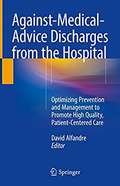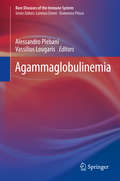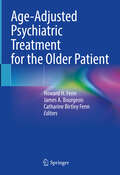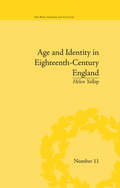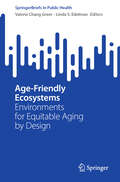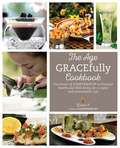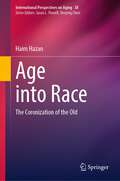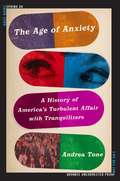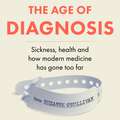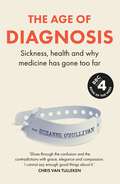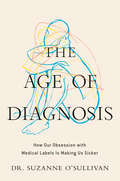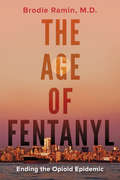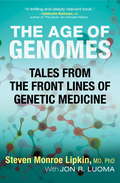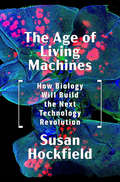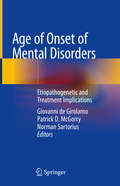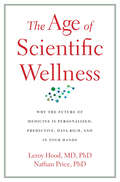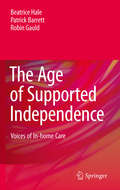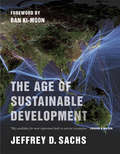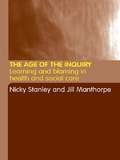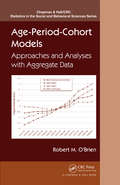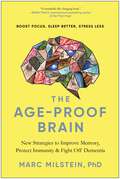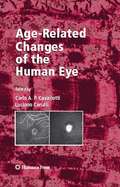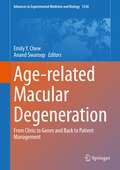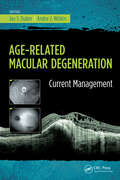- Table View
- List View
Against‐Medical‐Advice Discharges from the Hospital: Optimizing Prevention And Management To Promote High Quality, Patient-Centered Care
by David AlfandreFirst-of-its-kind text addressing the problem of against medical advice discharges in hospital-based healthcare.<P><P> Provides a comprehensive, multidisciplinary overview of a significant health care quality problem.<P> Addresses the legal, ethical, and institutional aspects of the problem as well as provides a framework for best practices for varied clinical disciplines including emergency medicine, pediatrics, psychiatry, hospital medicine, and nursing.<P>This first-of-its-kind text provides a multidisciplinary overview of a significant problem in hospital-based healthcare: patients who decline inpatient medical care and leave the hospital against medical advice (AMA). Compared to standard hospital discharges, AMA discharges are associated with worse health and health services outcomes. Patients discharged AMA have been found to have disproportionately higher rates of substance use, psychiatric illness, and report stigmatization and reduced access to care. By providing a far reaching examination of AMA discharges for a wide academic and clinical audience, the book serves as a reference for clinical care, research, and the development of professional guidelines and institutional policy. The book provides both a broad overview of AMA discharges with chapters on the epidemiology, ethical and legal aspects, as well as social science perspectives. For clinicians in the disciplines of hospital medicine, pediatrics, emergency medicine, nursing, and psychiatry, the book also provides a patient-centered analysis of the problem, case-based discussions, and a discussion of best practices. This comprehensive review of AMA discharges and health care quality will interest physicians and other health care professionals, social workers, hospital administrators, quality and risk managers, clinician-educators, and health services researchers.
Agammaglobulinemia (Rare Diseases of the Immune System #4)
by Alessandro Plebani Vassilios LougarisThis book provides an updated overview of agammaglobulinemia, a rare form of primary immunodeficiency which is considered the prototype of the congenital humoral defects, and which is characterized by the absence of peripheral B cells and very low serum immunoglobulin levels. The book opens by discussing the highly orchestrated early B cell development in the bone marrow and the genes involved based on both human and animal models. The pathogenesis and clinical presentation of X-linked agammaglobulinemia, caused by mutations in the BTK (Bruton's tyrosine kinase) gene, are then presented in detail, followed by descriptions of the clinical manifestations and molecular basis of the less frequent autosomal recessive and autosomal dominant forms of agammaglobulinemia. Patients' management in terms of respiratory complications, gammaglobulin replacement therapy and the potential value of novel experimental therapeutic strategies are discussed. The book's closing chapters offer a comprehensive and updated description of mutations in the BTK gene, and the expression and function of BTK in cells other than B cells.
Age-Adjusted Psychiatric Treatment for the Older Patient
by James A. Bourgeois Howard H. Fenn Catharine Birtley FennThis book offers practical age-adjusted recommendations to treat the most common psychiatric symptoms and syndromes in the geriatric patient. The principles described here are not new; advice for prescribing to the aging patient has always been to “start low, go slow.” This book fleshes out that dictum based on research evidence, clinical experience, and trends in the literature. An age-adjusted approach endorses medication interventions when needed as part of a comprehensive treatment plan. A combination of psychotherapeutic interventions, non-pharmacological modalities, and judiciously managed medications can improve quality of life and minimize risks inherent in pharmacotherapy applied to aging physiology.Age-Adjusted Psychiatric Treatment for the Older Patient is divided into five sections, covering the foundations of evaluation and treatment, neurocognitive disorders, psychiatric syndromes, therapeutics and interventions, and special topics. Each chapter begins with a complex case example that illustrates the topic. It then reviews current evidence-based evaluation and treatments. Age-adjusted recommendations, distilled from the literature, are offered at the end of each chapter. The intent is to provide actionable advice to supplement, but not supplant, good clinical judgement, which can improve quality of life by managing psychiatric symptomatology while averting untoward results.This volume is an essential guide for experienced clinicians as well as trainees across many health care disciplines, both generalists and geriatric specialists, who all see increasing numbers of aged patients with psychiatric symptomatology.
Age and Identity in Eighteenth-Century England ("The Body, Gender and Culture" #11)
by Helen YallopYallop looks at how people in eighteenth-century England understood and dealt with growing older. Though no word for ‘aging’ existed at this time, a person’s age was a significant aspect of their identity.
Age-Friendly Ecosystems: Environments for Equitable Aging by Design (SpringerBriefs in Public Health)
by Valerie Chang Greer Linda S. EdelmanThis compact book examines age friendliness within the framework of age-friendly ecosystems, and from a place-based approach, considering anchor institutions of neighborhoods, campuses and health environments as sites uniquely positioned to catalyze age equity and inclusivity. Age friendliness has grown from an idea into a social movement that recognizes the diversity of older adults, and integrates research, policy, programming and design practices. Compounding pressures of rapid aging, systemic ageism, and a growing disparity of resources compel us to rethink how we achieve equity in aging through the design of places and practices. Content for this book draws from a 2022 symposium, Age Friendly Communities as Platforms for Equity, Health & Wellness. Contributors build upon the content shared through the symposium in order to examine how neighborhoods, campuses and health environments are uniquely poised to support equity and to extend reach to historically marginalized populations of older adults. Ideas and experiences from national experts in aging, as well as "real world" experiences and narratives shared by older adults, students, community stakeholders and faculty researchers, are presented through a place-based approach. Collectively the voices in this book create a lens for empowering age-friendly ecosystems as environments for equitable aging by design. Among the topics covered: Creating an Age-Friendly Environment Across the Ecosystem Age Friendliness as a Framework for Equity in Aging Age-Friendly Voices in the Pursuit of an Age-Friendly Ecosystem Age-Friendly Futures: Equity by Design Age-Friendly Ecosystems: Environments for Equitable Aging by Design is written for people who are interested in understanding how the age-friendly movement is transforming places we live – community planners, designers, policy makers, aging service providers, academics and citizen activists. This compact volume presents a case of need for age friendliness in places we live, learn and care for our health. Readers with interests in the professional practice areas of aging studies/gerontology, architecture and planning, colleges and universities, community/neighborhood development, health systems, research, and policy will benefit from this brief that examines neighborhoods, campuses, and health environments from interdisciplinary perspectives.
The Age GRACEfully Cookbook: The Power of FOODTRIENTS To Promote Health and Well-being for a Joyful and Sustainable Life
by Grace OFoodTrients, originated by Grace O, is a unique program supported by current research that positions food as an anti-aging strategy for achieving sustainable health. A FoodTrient is her name for the natural anti-aging properties of food. Delicious foods and rejuvenating nutrients combine to create Aging GRACEfully Cookbook, a collection of enticing and nourishing recipes that promote health and well-being for a joyful and sustainable life. The recipes are built on the foundations of modern scientific research and ancient knowledge of medicinal herbs and natural ingredients from cultures all around the world. There are many books about super foods and supplements, but few provide at-a-glance guides in each recipe detailing key ingredients and how they increase health and longevity. Grace O’s cookbook focuses on five categories of FoodTrient that are essential to healthful living: Antioxidant: Prevents and repairs oxidative damage to cells caused by free radicals Anti-inflammatory: Reduce inflammatory process in cells, tissues, and blood vessels, helping to slow aging and reduce risk of long-term disease Immunity Boosters: Support the body’s resistance to infection and strengthen immune vigilance and response Mind and Beauty: Enhancers that encourage vibrant skin and hair and improve mood and mental agility Disease-Preventing: Reduces risk factors for common degenerative and age-related diseases These sixty-six beautifully illustrated recipes incorporate all the ingredients you need to look and feel younger, not only on the inside but also on the outside.
Age into Race: The Coronization of the Old (International Perspectives on Aging #38)
by Haim HazanAge into Race is a socio-anthropological essay on the repercussions of the Covid-19 pandemic on the cultural status of the old. As the worldwide horrors of the Corona era have since been publicly repressed, the text is geared to revisit and relive the tenor of that time while considering its latent revolutionary aftermath. There was wide agreement that Covid-19 policies targeted older people as a risk group in need of protection, setting it apart from the rest of society. Yet, paradoxically, long-term facilities for older people effectively became Covid-19 death traps. What kind of abandonment propelled this apparent contradiction? This book provides an answer by looking at ageist practices regarding Covid-19 triaging, lockdowns and distancing that affected older people around the world, devising Covid-19 as an inevitable "problem of the elderly" and, by implication, instating and categorizing "the elderly" as a public problem to be bio-politically managed and wrought. The Covid-19 pandemic and its concomitant "state of emergency" triggered an accelerated transmutation of customary ageism into emergent racism, spelling a fatal switch to designating the old as bearers of "bare" life unworthy of human living, thus turning old age from a seemingly cultural category to a socially fabricated viral menace of nature. The book tracks down the process through which the "Coronization" of culture legitimized and impelled a further stigmatization of old age beyond mere ageism to sheer racism. Thus, this transmutation, while compromising their autonomy and subjectivity via imposed lockdowns, social isolation, excommunication and selective discrimination rendered the old a race apart. Subsequently, the moral panic invoked by the specter of the pandemic transformed the social perceptions of later life from a containable social problem to an unbridled public hazard that summoned total measures presented as bureaucratically regimented regulations that dehumanized its victims with impunity.
The Age of Anxiety: A History of America's Turbulent Affair with Tranquilizers
by Andrea ToneAnxious Americans have increasingly pursued peace of mind through pills and prescriptions. In 2006, the National Institute of Mental Health estimated that 40 million adult Americans suffer from an anxiety disorder in any given year: more than double the number thought to have such a disorder in 2001. Anti-anxiety drugs are a billion-dollar business. Yet as recently as 1955, when the first tranquilizer-Miltown-went on the market, pharmaceutical executives worried that there wouldn't be interest in anxiety-relief. At mid-century, talk therapy remained the treatment of choice.But Miltown became a sensation-the first psychotropic blockbuster in United States history. By 1957, Americans had filled 36 million prescriptions. Patients seeking made-to-order tranquility emptied drugstores, forcing pharmacists to post signs reading "more Miltown tomorrow." The drug's financial success and cultural impact revolutionized perceptions of anxiety and its treatment, inspiring the development of other lifestyle drugs including Valium and Prozac.In The Age of Anxiety, Andrea Tone draws on a broad array of original sources-manufacturers' files, FDA reports, letters, government investigations, and interviews with inventors, physicians, patients, and activists-to provide the first comprehensive account of the rise of America's tranquilizer culture. She transports readers from the bomb shelters of the Cold War to the scientific optimism of the Baby Boomers, to the "just say no" Puritanism of the late 1970s and 1980s.A vibrant history of America's long and turbulent affair with tranquilizers, The Age of Anxiety casts new light on what it has meant to seek synthetic solutions to everyday angst.
The Age of Diagnosis: Sickness, Health and Why Medicine Has Gone Too Far
by Suzanne O’Sullivan'Slices through the confusion with grace and compassion. I cannot say good enough things about it.' - CHRIS VAN TULLEKEN'A brilliant study of the dangers of overdiagnosis' - GUARDIAN, book of the day'Be prepared for compassionate and bracingly independent thinking' - THE TIMES, best books of 2025From autism to allergies, ADHD to long Covid, more people are being labelled with medical conditions than ever before. But can a diagnosis do us more harm than good? The boundaries between sickness and health are being redrawn. Mental health categories are shifting and expanding all the time, radically altering what we consider to be 'normal'. Genetic tests can now detect pathologies decades before people experience symptoms, and sometimes before they're even born. And increased health screening draws more and more people into believing they are unwell. An accurate diagnosis can bring greater understanding and of course improved treatment. But many diagnoses aren't as definitive as we think. And in some cases they risk turning healthy people into patients. Drawing on the stories of real people, as well as decades of clinical practice and the latest medical research, Dr Suzanne O'Sullivan overturns long held assumptions and reframes how we think about illness and health.
The Age of Diagnosis: Sickness, Health and Why Medicine Has Gone Too Far
by Suzanne O’Sullivan'Covers so many topics that have been troubling me but I haven't been able to resolve myself - as a parent and a clinician. An absolutely absorbing read from start to finish.' - CHRIS VAN TULLEKEN'A brilliant study of the dangers of overdiagnosis' - GUARDIAN, book of the day'Compassionate and bracingly independent thinking' - THE TIMES, best books of 2025From autism to allergies, ADHD to long Covid, more people are being labelled with medical conditions than ever before. But can a diagnosis do us more harm than good? The boundaries between sickness and health are being redrawn. Mental health categories are shifting and expanding all the time, radically altering what we consider to be 'normal'. Genetic tests can now detect pathologies decades before people experience symptoms, and sometimes before they're even born. And increased health screening draws more and more people into believing they are unwell. An accurate diagnosis can bring greater understanding and of course improved treatment. But many diagnoses aren't as definitive as we think. And in some cases they risk turning healthy people into patients. Drawing on the stories of real people, as well as decades of clinical practice and the latest medical research, Dr Suzanne O'Sullivan overturns long held assumptions and reframes how we think about illness and health.
The Age of Diagnosis: How Our Obsession with Medical Labels Is Making Us Sicker
by Suzanne O'SullivanFrom a neurologist and the award-winning author of The Sleeping Beauties, a meticulous and compassionate exploration of how our culture of medical diagnosis can harm, rather than help, patients.We live in an age of diagnosis. Conditions like ADHD and autism are on the rapid rise, while new categories like long Covid are being created. Medical terms are increasingly used to describe ordinary human experiences, and the advance of sophisticated genetic sequencing techniques means that even the healthiest of us may soon be screened for potential abnormalities. More people are labeled "sick" than ever before—but are these diagnoses improving their lives?With scientific authority and compassionate storytelling, neurologist Suzanne O'Sullivan argues that our obsession with diagnosis is harming more than helping. It is natural when we are suffering to want a clear label, understanding, and, of course, treatment. But our current approach to diagnosis too often pathologizes difference, increases our anxiety, and changes our experience of our bodies for the worse.Through the moving stories of real people, O'Sullivan compares the impact of a medical label to the pain of not knowing. She explains the way the boundaries of a diagnosis can blur over time. Most importantly, she calls for us to find new and better vocabularies for suffering and to find ways to support people without medicalizing them.
The Age of Fentanyl: Ending the Opioid Epidemic
by Brodie RaminIs there a way to end North America’s opioid epidemic? In The Age of Fentanyl, Brodie Ramin tells the story of the opioid crisis, showing us the disease and cure from his perspective as an addiction doctor working on the front lines. We meet his patients, hear from other addiction experts, and learn about the science and medicine of opioid addiction and its treatments. He shows us how addiction can be prevented, how knowledge can reduce stigma, and how epidemics can be beaten. Dr. Ramin brings the hopeful message that just as patients and health care workers rallied together to fight HIV one generation ago, a coalition of patients, advocates, scientists, doctors, and nurses is once again finding solutions and making plans to stem the overdose deaths, block the spread of fentanyl, and end the epidemic.
The Age of Genomes: Tales from the Front Lines of Genetic Medicine
by Steven Monroe Lipkin Jon LuomaA leading geneticist explores what promises to be one of the most transformative advances in health and medicine in historyAlmost every week, another exciting headline appears about new advances in the field of genetics. Genetic testing is experiencing the kind of exponential growth once seen with the birth of the Internet, while the plummeting cost of DNA sequencing makes it increasingly accessible for individuals and families.Steven Lipkin and Jon Luoma posit that today's genomics is like the last century's nuclear physics: a powerful tool for good if used correctly, but potentially dangerous nonetheless. DNA testing is likely the most exciting advance in a long time for treating serious disease, but sequencing errors, complex biology, and problems properly interpreting genetic data can also cause life-threatening misdiagnoses of patients with debilitating and fatal genetic diseases. DNA testing can also lead to unnecessary procedures and significantly higher health-care costs. And just around the corner is the ability to cure genetic diseases using powerful gene-editing technologies that are already being used in human embryo research. Welcome to the Age of Genomes!The Age of Genomes immerses readers in true stories of patients on the frontier of genomic medicine and explores both the transformative potential and risks of genetic technology. It will inform anxious parents increasingly bombarded by offers of costly new prenatal testing products, and demonstrate how genetic technology, when deployed properly, can significantly improve the lives of patients who have devastating neurological diseases, cancer, and other maladies. Dr. Lipkin explains the science in depth, but in terms a layperson can follow.
The Age of Living Machines: How Biology Will Build The Next Technology Revolution
by Susan HockfieldFrom the former president of MIT, the story of the next technology revolution, and how it will change our lives. A century ago, discoveries in physics came together with engineering to produce an array of astonishing new technologies: radios, telephones, televisions, aircraft, radar, nuclear power, computers, the Internet, and a host of still-evolving digital tools. These technologies so radically reshaped our world that we can no longer conceive of life without them. Today, the world’s population is projected to rise to well over 9.5 billion by 2050, and we are currently faced with the consequences of producing the energy that fuels, heats, and cools us. With temperatures and sea levels rising, and large portions of the globe plagued with drought, famine, and drug-resistant diseases, we need new technologies to tackle these problems. But we are on the cusp of a new convergence, argues world-renowned neuroscientist Susan Hockfield, with discoveries in biology coming together with engineering to produce another array of almost inconceivable technologies—next-generation products that have the potential to be every bit as paradigm shifting as the twentieth century’s digital wonders. The Age of Living Machines describes some of the most exciting new developments and the scientists and engineers who helped create them. Virus-built batteries. Protein-based water filters. Cancer-detecting nanoparticles. Mind-reading bionic limbs. Computer-engineered crops. Together they highlight the promise of the technology revolution of the twenty-first century to overcome some of the greatest humanitarian, medical, and environmental challenges of our time.
Age of Onset of Mental Disorders: Etiopathogenetic and Treatment Implications
by Giovanni De Girolamo Patrick D. McGorry Norman SartoriusThis book presents a thorough and critical review of current knowledge about the age of onset of mental disorders. The opening chapters offer information about the impact of the age of onset on the clinical picture, course, and outcome of physical illnesses, and about the neurobiological implications and correlates of different ages of onset. The impact and correlates of the ages of onset of all the most important mental disorders are then discussed in detail by internationally renowned scientists. The background to the book is the recognition that a better understanding of age of onset makes it possible to estimate the lifetime risk of disorders, helps to elucidate pathogenesis, and facilitates efficient, targeted clinical management. The book will be of value for clinicians, mental health professionals, mental health researchers, epidemiologists, and different stakeholders in the mental health field.
The Age of Scientific Wellness: Why the Future of Medicine Is Personalized, Predictive, Data-Rich, and in Your Hands
by Leroy Hood Nathan PriceTaking us to the cutting edge of the new frontier of medicine, a visionary biotechnologist and a pathbreaking researcher show how we can optimize our health in ways that were previously unimaginable.We are on the cusp of a major transformation in healthcare—yet few people know it. At top hospitals and a few innovative health-tech startups, scientists are working closely with patients to dramatically extend their “healthspan”—the number of healthy years before disease sets in. In The Age of Scientific Wellness, two visionary leaders of this revolution in health take us on a thrilling journey to this new frontier of medicine.Today, most doctors wait for clinical symptoms to appear before they act, and the ten most commonly prescribed medications confer little or no benefit to most people taking them. Leroy Hood and Nathan Price argue that we must move beyond this reactive, hit-or-miss approach to usher in real precision health—a form of highly personalized care they call “scientific wellness.” Using information gleaned from our blood and genes and tapping into the data revolution made possible by AI, doctors can catch the onset of disease years before symptoms arise, revolutionizing prevention. Current applications have shown startling results: diabetes reversed, cancers eliminated, Alzheimer’s avoided, autoimmune conditions kept at bay.This is not a future fantasy: it is already happening, but only for a few patients and at high cost. It’s time to make this gold standard of care more widely available. Inspiring in its possibilities, radical in its conclusions, The Age of Scientific Wellness shares actionable insights to help you chart a course to a longer, healthier, and more fulfilling life.
The Age of Supported Independence
by Beatrice Hale Robin Gauld Patrick BarrettThis book investigates the experiences of older people who remain at home with care. It examines the transition points for the important life changes faced by family members who take on a greater care-giving role. The book draws on demographic analyses and qualitative fieldwork to explore the shift from independence to increasing dependence, and suggests that this transition constitutes movement into a new stage of life, that of an Age of Supported Independence. Applying the anthropological concept of rites of passage in their analysis, the authors focus on the changes in everyday living within the spatial environment of the home, the temporal organization of daily life, and the reshaping of relationships. They suggest that many older people - as well as the family members who become carers - remain in a state of 'liminality': unable to make sense of their new situation and experience and, despite assumptions that ageing-in-place sustains social connectedness, excluded from their communities.
The Age of Sustainable Development
by Jeffrey D. SachsJeffrey D. Sachs has shown himself to be one of the world's most perceptive and original analysts of global development in his groundbreaking books, including The End of Poverty and Common Wealth: Economics for a Crowded Planet. Now, in this major new work he presents a compelling and practical framework for how global citizens can address the seemingly intractable worldwide problems of persistent extreme poverty, environmental degradation, and political-economic injustice. Sachs outlines the holistic way forward: sustainable development. This provocative work offers readers, students, activists, environmentalists, and policy makers the tools, metrics, and practical pathways they need to achieve Sustainable Development Goals. Far more than a rhetorical exercise, this book is designed to inform, inspire, and spur action. Based on Sachs's twelve years as director of the Earth Institute at Columbia University, his thirteen years advising the United Nations secretary-general on the Millennium Development Goals, and his recent presentation of these ideas in a popular online course, The Age of Sustainable Development is a landmark publication and a clarion call for all who care about our planet and global justice.
The Age of Sustainable Development
by Jeffrey D. SachsJeffrey D. Sachs is one of the world's most perceptive and original analysts of global development. In this major new work he presents a compelling and practical framework for how global citizens can use a holistic way forward to address the seemingly intractable worldwide problems of persistent extreme poverty, environmental degradation, and political-economic injustice: sustainable development. <P><P>Sachs offers readers, students, activists, environmentalists, and policy makers the tools, metrics, and practical pathways they need to achieve Sustainable Development Goals. Far more than a rhetorical exercise, this book is designed to inform, inspire, and spur action. Based on Sachs's twelve years as director of the Earth Institute at Columbia University, his thirteen years advising the United Nations secretary-general on the Millennium Development Goals, and his recent presentation of these ideas in a popular online course, The Age of Sustainable Development is a landmark publication and clarion call for all who care about our planet and global justice.
The Age of the Inquiry: Learning and Blaming in Health and Social Care
by Nicky Stanley Jill ManthorpeThe plethora of inquiry reports published in the fields of health and welfare in the 1990s covered the full range of user groups, individuals and institutions. What similarities or differences were there between these inquiries? How effective were they in bringing about change? Whose interest did they best serve?These are some of the questions The Age of the Inquiry explores in detail, bringing together distinguished contributors with personal experience of chairing or providing evidence to inquiries to consider: the participant's view of inquiriesthe purpose of inquiriesthe impact of inquiries on health and social policyinquiries into: child abuse and death; homicides by mental health service users; the abuse of adults with learning disabilities; the abuse of older people. Wide-ranging in scope, The Age of the Inquiry focuses on service and policy development. It provides an invaluable text for students, teachers and professionals from a wide range of disciplines and professional groups.
Age-Period-Cohort Models: Approaches and Analyses with Aggregate Data (Chapman & Hall/CRC Statistics in the Social and Behavioral Sciences)
by Robert O'BrienThis book presents an introduction to the problems and strategies for modeling age, period, and cohort (APC) effects for aggregate-level data. These strategies include constrained estimation, the use of age and/or period and/or cohort characteristics, estimable functions, variance decomposition, and a new technique called the s-constraint approach. Emphasizing both the geometry and algebra of several APC approaches, the book develops readers' understanding of the statistical issues of APC analysis and shows how common methods are related to each other.
The Age-Proof Brain: New Strategies to Improve Memory, Protect Immunity, and Fight Off Dementia
by Marc Milstein&“An absolutely fabulous, invaluable read!&” —Dr. James B. Maas, Weiss Presidential Fellow, former professor and chair of psychology, Cornell University &“A wonderful, life-changing book.&” —Brian Tracy, international bestselling author of Eat That Frog! Serious mental decline is not an inevitable part of aging. You can boost your short and long-term brain health and significantly lower the risk of dementia—if the right steps are taken now. Fifty million people have dementia worldwide, but it doesn&’t have to be that way. We—not our genes—can control our cognitive destiny. Serious mental decline is not an inevitable part of aging. You can boost your short- and long-term brain health and significantly lower the risk of dementia—if the right steps are taken now. In The Age-Proof Brain, scientist and popular speaker Dr. Marc Milstein reveals the secrets to improving brain function, which lie in the brain&’s surprising connection with the rest of the body. Debunking common misinformation, he offers science-driven strategies in an entertaining, motivating, and easy-to-follow guide to: Improve memory and productivity Increase energy and boost your mood Reduce the risk of anxiety and depression Form healthy habits to supercharge your brain Prevent nongenetic Alzheimer&’s and dementia Dr. Milstein arms you with knowledge about common and often overlooked issues that prematurely age the brain (including the surprising truth about what doctors previously got wrong about Alzheimer&’s and dementia), and shares a seven-day challenge to help you jump-start new brain-healthy habits. Small changes can make a big difference right away. The Age-Proof Brain will provide the tools you need to ensure that you&’re living a happier and more fulfilling life—today, tomorrow, and well into your future.
Age-Related Changes of the Human Eye (Aging Medicine)
by Carlo Cavallotti Luciano CerulliAging research on the human eyes crosses all areas of ophthalmology and also relies upon biological, morphological, physiological, and biochemical tools for its study. This book reviews all aspects of human eye aging. In addition to descriptions of age-related changes in almost all the structures of the human eyes, the authors also include interesting accounts of personal experiments and data. It provides an extensive panorama of what happens during aging in the eye.
Age-related Macular Degeneration: From Clinic to Genes and Back to Patient Management (Advances in Experimental Medicine and Biology #1256)
by Emily Y. Chew Anand SwaroopThis edited book focuses on the recent advances in our understanding of age-related macular degeneration (AMD), combining epidemiology and clinical diagnosis, with genetics and immunological aspects as well as the role of proteostasis and mitochondria before diving into new therapies including stem cell based approaches. AMD is a leading cause of largely incurable blindness worldwide and projected to double from 2.07 million to 5.44 million individuals by 2050 in the United States. Globally, 288 million individuals are projected to have AMD by 2040. The disease has enormous socioeconomic impact on the affected individuals, their families and the society. This book will bring together the state of the art basic science knowledge with clinically relevant findings and address the challenges for future research in AMD. The intersection of different disciplines will provide potential areas for further investigations to reduce the burden of blindness from AMD. This book offers an appealing and insightful resource for clinicians, scientists, students and fellows.
Age-Related Macular Degeneration: Current Management
by Jay Duker Andre WitkinRetinal disease in general, and age-related macular degeneration (AMD) specifically, is of major interest worldwide due to the increasing aging population and the revolution in management of wet AMD over the past several years. Age-Related Macular Degeneration presents an up-to-date, clinically relevant monograph on the current diagnosis and management of AMD.Age-Related Macular Degeneration by Drs. Jay S. Duker and Andre J. Witkin serves as a reference for ophthalmologists treating AMD in the clinic as well as other eye care professionals who see and counsel patients with AMD. Chapters will focus on the pathogenesis and risk factors for AMD, the diagnosis of AMD, treatment options, and promising investigative interventions. To help readers gain familiarity recognizing AMD, the book contains multiple images in different formats: high quality color fundus photographs, black-and-white angiograms, black-and-white autofluorence images, and both color and black-and-white OCT images.Relevant to current management of AMD, Age-Related Macular Degeneration: Current Management concentrates on “clinical utility” rather than emphasizing published studies, filling the current void in the market for the general ophthalmology and optometry audience. Comprehensive ophthalmologists, optometrists and retinal specialists will appreciate the book’s practical approach to AMD.
